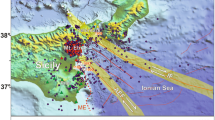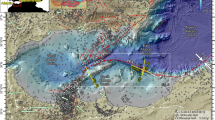Abstract
Oblique extension across strike-slip faults causes subsidence and leads to the formation of pull-apart basins such as the Salton Sea in southern California. The formation of these basins has generally been studied using laboratory experiments or numerical models1,2,3,4. Here we combine seismic reflection data and geological observations from the Salton Sea to understand the evolution of this nascent pull-apart basin. Our data reveal the presence of a northeast-trending hinge zone that separates the sea into northern and southern sub-basins. Differential subsidence (>10 mm yr−1) in the southern sub-basin suggests the existence of northwest-dipping basin-bounding faults near the southern shoreline, which may control the spatial distribution of young volcanism. Rotated and truncated strata north of the hinge zone suggest that the onset of extension associated with this pull-apart basin began after ∼0.5 million years ago. We suggest that slip is partitioned spatially and temporally into vertical and horizontal domains in the Salton Sea. In contrast to previous models based on historical seismicity patterns5, the rapid subsidence and fault architecture that we document in the southern part of the sea are consistent with experimental models for pull-apart basins1.
This is a preview of subscription content, access via your institution
Access options
Subscribe to this journal
Receive 12 print issues and online access
$259.00 per year
only $21.58 per issue
Buy this article
- Purchase on Springer Link
- Instant access to full article PDF
Prices may be subject to local taxes which are calculated during checkout



Similar content being viewed by others
References
Basile, C. & Brun, J. P. Transtensional faulting patterns ranging from pull-apart basins to transform continental margins: An experimental investigation. J. Struct. Geol. 21, 23–37 (1999).
Wu, J. E., McClay, K., Whitehouse, P. & Dooley, T. 4D analogue modelling of transtensional pull-apart basins. Mar. Petrol. Geol. (in the press).
McClay, K. & Dooley, T. Analog models of pull-apart basins. Geology 23, 711–714 (1995).
Katzman, R., ten Brink, U. S. & Lin, J. A. 3-Dimensional modeling of pull-apart basins—implications for the tectonics of the dead-sea basin. J. Geophys. Res. 100, 6295–6312 (1995).
Nicholson, C., Seeber, L., Williams, P. & Sykes, L. R. Seismic evidence for conjugate slip and block rotation within the San-Andreas Fault System, Southern California. Tectonics 5, 629–648 (1986).
Seeber, L. et al. Rapid subsidence and sedimentation from oblique slip near a bend on the North Anatolian transform fault in the Marmara Sea, Turkey. Geology 34, 933–936 (2006).
Elders, W. A., Biehler, S., Rex, R. W., Robinson, P. T. & Meidav, T. Crustal spreading in Southern California. Science 178, 15–24 (1972).
Fuis, G. S., Mooney, W. D., Healy, J. H., Mcmechan, G. A. & Lutter, W. J. A seismic refraction survey of the Imperial-Valley Region, California. J. Geophys. Res. 89, 1165–1189 (1984).
Hudnut, K. et al. Surface ruptures on cross-faults in the 24 November 1987 Superstition Hills, California, earthquake sequence. Bull. Seismol. Soc. Am. 79, 282–296 (1989).
Hardebeck, J. L. & Shearer, P. M. Using S/P amplitude ratios to constrain the focal mechanisms of small earthquakes. Bull. Seismol. Soc. Am. 93, 2434–2444 (2003).
Lin, G. Q., Shearer, P. M. & Hauksson, E. Applying a three-dimensional velocity model, waveform cross correlation, and cluster analysis to locate southern California seismicity from 1981 to 2005. J. Geophys. Res. 112, B12309 (2007).
Newmark, R. L., Kasameyer, P. W. & Younker, L. W. Shallow drilling in the Salton-Sea Region—the thermal anomaly. J. Geophys. Res. 93, 13005–13023 (1988).
Schmitt, A. K. & Vazquez, J. A. Alteration and remelting of nascent oceanic crust during continental rupture: Evidence from zircon geochemistry of rhyolites and xenoliths from the Salton Trough, California. Earth Planet. Sci. Lett. 252, 260–274 (2006).
Waters, M. R. Late holocene lacustrine chronology and archaeology of ancient Lake Cahuilla, California. Quat. Res. 19, 373–387 (1983).
Philibosian, B. Paleoseismology of the San Andreas Fault at Coachella, California. Master’s thesis, Univ. Oregon (2007).
Kirby, S. M. et al. Pleistocene brawley and ocotillo formations: Evidence for initial strike-slip deformation along the San Felipe and San Jacinto fault zones, southern California. J. Geol. 115, 42–62 (2007).
Hudnut, K. W., Seeber, L. & Pacheco, J. Cross-fault triggering in the November 1987 Superstition Hills earthquake sequence, Southern California. Geophys. Res. Lett. 16, 199–202 (1989).
Burgmann, R. Transpression along the Southern San-Andreas Fault, Durmid Hill, California. Tectonics 10, 1152–1163 (1991).
Larsen, S. & Reilinger, R. Age constraints for the present fault configuration in the Imperial Valley, California—evidence for Northwestward propagation of the Gulf of California Rift System. J. Geophys. Res. 96, 10339–10346 (1991).
Johnson, C. E. & Hadley, D. M. Tectonic implications of the Brawley Earthquake Swarm, Imperial Valley, California, January 1975. Bull. Seismol. Soc. Am. 66, 1133–1144 (1976).
Behr, W. et al. SCEC Annual Meeting, Proceedings and Abstracts Vol. 17, 87 (2007).
Meade, B. J. & Hager, B. H. Block models of crustal motion in southern California constrained by GPS measurements. J. Geophys. Res. 110, B04402 (2005).
Hudnut, K. W., Seeber, L. & Rockwell, T. Slip on the Elmore Ranch Fault during the past 330 years and its relation to slip on the Superstition Hills Fault. Bull. Seismol. Soc. Am. 79, 330–341 (1989).
Lohman, R. B. & McGuire, J. J. Earthquake swarms driven by aseismic creep in the Salton Trough, California. J. Geophys. Res. 112, B04405 (2007).
Aydin, A. & Nur, A. Evolution of pull apart basins and their scale independence. Tectonics 1, 91–105 (1982).
Steely, A. N., Janecke, S. U., Dorsey, R. J. & Axen, G. J. Early Pleistocene initiation of the San Felipe fault zone, SW Salton Trough, during reorganization of the San Andreas fault system. Geol. Soc. Am. Bull. 121, 663–687 (2009).
Lutz, A. T., Dorsey, R. J., Housen, B. A. & Janecke, S. U. Stratigraphic record of Pleistocene faulting and basin evolution in the Borrego Badlands, San Jacinto fault zone, Southern California. Geol. Soc. Am. Bull. 118, 1377–1397 (2006).
URS. Preliminary in-sea geotechnical investigation, Salton Sea Restoration Project Report (Riverside and Imperial Counties, 2004).
Meltzner, A. J., Rockwell, T. K. & Owen, L. A. Recent and long-term behavior of the Brawley Fault Zone, Imperial Valley, California: An escalation in slip rate? Bull. Seismol. Soc. Am. 96, 2304–2328 (2006).
Kreemer, C., Holt, W. E. & Haines, A. J. An integrated global model of present-day plate motions and plate boundary deformation. Geophys. J. Int. 154, 8–34 (2003).
Acknowledgements
Funding for this work was provided by the California Department of Water Resources, California Department of Fish and Game, UCSD Academic Senate, Scripps Institution of Oceanography, National Science Foundation (grants OCE-0112058 and EAR-0545250) and Southern California Earthquake Center (grant 2008-08127). We would like to thank B. Philibosian, D. Sandwell and D. Kilb for discussions, and V. Langenheim for a review.
Author information
Authors and Affiliations
Contributions
D.S.B. planned field surveys, collected, analysed and interpreted the data and wrote the manuscript. N.W.D. and G.M.K. planned field surveys, collected and interpreted the data and provided extensive feedback on the manuscript. A.J.H., J.M.B. and R.L.B. collected data and provided feedback on the manuscript.
Corresponding author
Supplementary information
Supplementary Information
Supplementary Information (PDF 860 kb)
Rights and permissions
About this article
Cite this article
Brothers, D., Driscoll, N., Kent, G. et al. Tectonic evolution of the Salton Sea inferred from seismic reflection data. Nature Geosci 2, 581–584 (2009). https://doi.org/10.1038/ngeo590
Received:
Accepted:
Published:
Issue Date:
DOI: https://doi.org/10.1038/ngeo590
This article is cited by
-
Offshore/onshore correlation of the North-Anatolian fault deformations in the Western Sea of Marmara
Natural Hazards (2021)
-
Sedimentary signals of recent faulting along an old strand of the San Andreas Fault, USA
Scientific Reports (2018)
-
Loading of the San Andreas fault by flood-induced rupture of faults beneath the Salton Sea
Nature Geoscience (2011)
-
Pulling plates apart
Nature Geoscience (2009)



